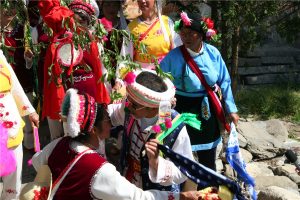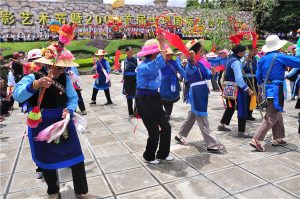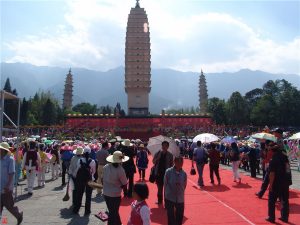 alt="Puer Surrounding Counties and Towns: Weekly & Special Local Markets Travel Guide"
/>
alt="Puer Surrounding Counties and Towns: Weekly & Special Local Markets Travel Guide"
/>
Raosanling Ceremony of Bai Ethnic Minority in Dali

Raosanling Ceremony
Raosanling Ceremony is one of the important folk festivals of Bai Ethnic Minority in Dali region, which originated from Nanzhao and was originally a ritual of Bai nationality’s ancient religious sacrifice. Raosanling is called “Guanshanglan”(逛山林)( “strolling through mountains and forests). It is spread in Bai villages in Cangshan(苍山) urhai(洱海) area of Dali Bai Autonomous Prefecture. So far, it has a history of more than 1000 years. In 2006, it was approved by the State Council to be included in the first batch of national intangible cultural heritage list.
The Origin And Meaning of the Celebrate
“Three spirits” refers to the three God symbols on the West Bank of Erhai Lake. They are the important masters worshiped by Bai nationality and the Buddhist gods introduced into Dali area. The temples dedicated to them are called “Buddha Capital” (Dali Holy Temple), “Shendu神都” (Duan Zongbang Temple段宗榜) and “Xiandu仙都” (Duan Chicheng’s Erhe Temple段赤诚的洱河神祠). There are different legends about the origins of the three spirits. It is more common to say that the villagers of 71 villages in Dali worship the central master of the “god capital” on behalf of the “owner”, and pray for a ceremony held in good years. Confused by witchcraft, praying for offspring and disaster. “Rao” is the meaning of singing and dancing.
When And How To Celebrate

Every year, from April 23 to 25 of the lunar calendar, men, women and children in Bai villages around Erhai Lake, led by a pair of singers dressed in disguise, sing and dance, begin to move around three flexible movements.
From Chongsheng Temple (Buddha Capital) , along Cangshan foothill “around” to Shengyuan Temple (Shendu) in Xizhou Qingdong(喜洲庆洞), the team carried out religious activities such as praying for the New Year in Shengyuan Temple(圣源寺) during the day, and at night they sang and danced in the fields and woods near Shengyuan Temle.
The next day, starting from Qingdong(庆洞), arrived at Jingui Temple (金圭寺) in Yicheng Village(矣城村), Riverside of Erhai Lake, offering sacrifices to the Lingdi Emperor of Erhe River. At night, they were still singing and dancing to entertaining gods.
On the third day, we walked south along the West Bank of Erhai Lake and returned to Majiuyi village(马久邑村) near Chongsheng Temple in Dali. During the three spirits period, tens of thousands of people participated and danced with men, women and children. Bai tune, Daben tune crificial tune, Sanxian(三弦), Suona(唢呐) tune were heard all the time. Money drum and tyrant whip rose and fell one after another.
Social Impact And Important Significance

Raosanling Ceremony has a long history of inheritance, a deep mass base, a large scale of activities, a vast space for visiting sacrifices, and pious attitudes of the participants, reflecting the Bai people’s ability to absorb and innovate in culture. They have a strong practical role in enhancing cultural identity and cohesion of the Bai people. They are symbols of Bai culture with symbolic significance. One of them is of great historical, scientific and artistic value. Its religious color is increasingly weak, and the content of cultural activities is increasingly rich and colorful. It has become a festival for Bai people’s spring outings and social activities.
Chinese Version: http://www.ynich.cn/view-ml-11110-1402.html
Translated by Winnie/张赢

 7 Days GolfingTour
7 Days GolfingTour
 8 Days Group Tour
8 Days Group Tour
 8 Days Yunnan Tour
8 Days Yunnan Tour
 7 Days Shangri La Hiking
7 Days Shangri La Hiking
 11 Days Yunnan Tour
11 Days Yunnan Tour
 6 Days Yuanyang Terraces
6 Days Yuanyang Terraces
 11 Days Yunnan Tour
11 Days Yunnan Tour
 8 Days South Yunnan
8 Days South Yunnan
 7 Days Tea Tour
7 Days Tea Tour
 8 Days Muslim Tour
8 Days Muslim Tour
 12 Days Self-Driving
12 Days Self-Driving
 4 Days Haba Climbing
4 Days Haba Climbing
 Tiger Leaping Gorge
Tiger Leaping Gorge
 Stone Forest
Stone Forest
 Yunnan-Tibet
Yunnan-Tibet
 Hani Rice Terraces
Hani Rice Terraces
 Kunming
Kunming
 Lijiang
Lijiang
 Shangri-la
Shangri-la
 Dali
Dali
 XishuangBanna
XishuangBanna
 Honghe
Honghe
 Kunming
Kunming
 Lijiang
Lijiang
 Shangri-la
Shangri-la
 Yuanyang Rice Terraces
Yuanyang Rice Terraces
 Nujiang
Nujiang
 XishuangBanna
XishuangBanna
 Spring City Golf
Spring City Golf
 Snow Mountain Golf
Snow Mountain Golf
 Stone Mountain Golf
Stone Mountain Golf













 What Our Customers Say?
What Our Customers Say?
